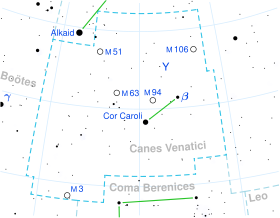Top Qs
Timeline
Chat
Perspective
Beta Canum Venaticorum
Star in constellation Canes Venatici From Wikipedia, the free encyclopedia
Remove ads
Beta Canum Venaticorum is the second-brightest star in the northern constellation of Canes Venatici. Its name is a Bayer designation; it has the proper name Chara, pronounced /ˈkɛərə/.[11][12] This is a nearby solar-type star, located 27.6 light-years (8.5 parsecs) distant based on its parallax. The star is faintly visible to the naked eye, at an apparent magnitude of +4.25. Along with the brighter star Cor Caroli, the pair form the "southern dog" in this constellation that represents hunting dogs.
Remove ads
Nomenclature
β Canum Venaticorum (Latinised to Beta Canum Venaticorum) is the star's Bayer designation, which is abbreviated Beta CVn or β CVn. It has the Flamsteed designation 8 Canum Venaticorum.[10] The star was listed in the New General Catalogue as NGC 4530.[13][14]
The traditional name Chara was originally applied to the "southern dog", but it later became used specifically to refer to Beta Canum Venaticorum. Chara (χαρά) means 'joy' in Greek[15] but ‘dear’ or ’beloved’ in Latin.[16] In 2016, the International Astronomical Union organized a Working Group on Star Names (WGSN)[17] to catalog and standardize proper names for stars. The WGSN's first bulletin of July 2016[18] included a table of the first two batches of names approved by the WGSN; which included Chara for this star.
In Chinese, 常陳 (Cháng Chén), meaning Imperial Guards, refers to an asterism consisting of Beta Canum Venaticorum, Alpha Canum Venaticorum, 10 Canum Venaticorum, 6 Canum Venaticorum, 2 Canum Venaticorum, and 67 Ursae Majoris.[19] Consequently, the Chinese name for Beta Canum Venaticorum itself is 常陳四 (Cháng Chén sì, English: the Fourth Star of Imperial Guards.)[20]
Remove ads
Characteristics
Summarize
Perspective
Beta CVn has a stellar classification of G0 V, and so is a G-type main-sequence star. Since 1943, the spectrum of this star has served as one of the stable anchor points by which other stars are classified.[21] The spectrum of this star shows a very weak emission line of singly ionized calcium (Ca II) from the chromosphere, making it a useful reference star for a reference spectrum to compare with other stars in a similar spectral category.[22] (The Ca-II emission lines are readily accessible and can be used to measure the level of activity in a star's chromosphere.)
Beta CVn is considered to be slightly metal-poor,[8] which means it has a somewhat lower portion of elements heavier than helium when compared to the Sun. In terms of mass, age and evolutionary status, however, this star is very similar to the Sun.[23] As a result, it has been called a solar analog. It is about 3% less massive than the Sun,[2] with a radius 3% larger than the Sun's and 25% greater luminosity.[7][8]
The components of this star's space velocity are (U, V, W) = (–25, 0, +2) km/s.[23] In the past it was suggested that it may be a spectroscopic binary. However, further analysis of the data does not seem to bear that out.[24] In addition, a 2005 search for a brown dwarf in orbit around this star failed to discover any such companion, at least down to the sensitivity limit of the instrument used.[25]
Remove ads
Habitability
In 2006, astronomer Margaret Turnbull labeled Beta CVn as the top stellar system candidate to search for extraterrestrial life forms.[26] Because of its solar-type properties, astrobiologists have listed it among the most astrobiologically interesting stars within 10 parsecs of the Sun.[23] However, as of 2009, this star is not known to host planets.[2]
See also
References
External links
Wikiwand - on
Seamless Wikipedia browsing. On steroids.
Remove ads

